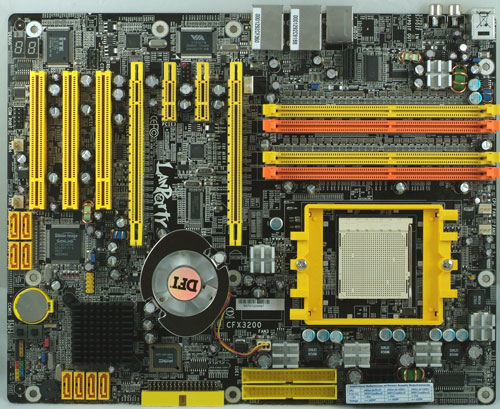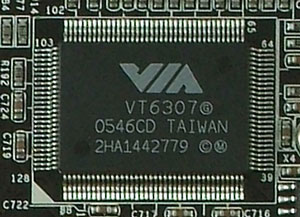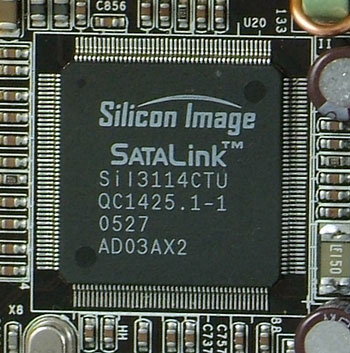DFI CFX3200-DR: ATI RD580 Tweak Attack
by Wesley Fink on May 8, 2006 12:05 AM EST- Posted in
- Motherboards
Board Layout

It has been quite a while since DFI released a new LANParty board with all the bells and whistles. Lately the new DFI boards seem to be LANParty UT - basically a LANParty board without the FrontX unit and Carrying harness. Since there are no full-blown LANParty versions of any of these recent boards, DFI should probably just drop the LANParty name since it no longer has any real meaning in their product line. The DFI CFX3200-DR is selling for over $200, however, which is still a LANParty price tag.

The DFI CFX3200-DR uses the ULi M1575 south bridge instead of the SB450 that was used on the RDX200. That means full support for 4 SATA2 devices, and fully competitive USB performance with 8 USB 2.0 ports. Of the current choices available to ATI chipset builders the ULi looks like the best choice. There are concerns about continued availability since NVIDIA bought ULi. Manufacturers fear that NVIDIA will limit or stop distribution of the M1575 Southbridge. Despite NVIDIA and ULi assurances it certainly appears that the M1575 is getting harder and harder to find these days. The good news is that the updated ATI SB600 with a much updated feature set is now sampling. With the SB600 expected at AM2 launch in a few weeks manufacturers will finally have a competitive ATI SB option for use with the RD580 Northbridge.
DFI decided to pass on the 2-chip NVIDIA dual X16 solution, so this CFX3200-DR is their first and only dual X16 board. Careful thought went into the X16 slot spacing, as DFI chose the 2-slot spacing to allow plenty of room for GPU cooling options.
 |
| Click to enlarge |
Appearance of the board is typical LANParty, with Day-Glo slots and matching neon cables. This is a love/hate kind of thing - some love the LANParty look while others prefer a more sedate appearance. The functional layout, on the other hand, is one that should work well for any system builder.

IDE/Floppy connectors are on the preferred right edge of the board, but it will be easiest to connect the floppy edge connector before screwing down the board.

Both the 24-pin ATX and the robust 8-pin 12v connectors are at the right board edge, out of the way of CPU and memory cooling.

Memory is in an unusual location, between the back IO ports and the CPU. This is not a common location but it works just as well as the more common location to the right of the CPU. Since the AM2 version will be the same except for DDR2 slots it will be interesting to see if DDR2 memory trace design may have influenced this new location. With many systems now using rear case fans, the RAM location may also provide for better cooling of the DIMMs, so while different the change certainly isn't bad.

Firewire has been ignored by DFI on many recent boards, but that is not the case on the CFX3200. A rear firewire port is included as well as a header for an additional IEEE1394 port. Firewire is driven by the VIA VT6307 chip. Some Firewire users would probably still like to see 1394B support, but 1394A is better than nothing.

As in previous LANParty motherboards, DFI has isolated HD audio on their ATI chipset designs to improve performance and signal-to-noise ratio. The Karajan module provides 8-channel High Definition Azalia audio using the Realtek ALC882. The Realtek is a well-regarded High Definition codec that has performed well in recent tests. Realtek has been upgrading their HD drivers frequently, and each new version seems to improve the performance a bit more. You can find more information on ALC882 HD at Realtek's site.
The ALC882 has superb specifications, providing five 24-bit stereo DACs and three 20-bit stereo DACs driving the multimedia features. All DACs provide sample rates to 192kHz and up to 4 channels of microphone input are supported. Signal-to Noise ratio is specified to be greater than 103dB. Realtek features the ALC882 as a premium HD part.

It is a real puzzle that DFI continues to use the Silicon Image 3114 SATA controller on their motherboards. This chip only supports the older SATA spec of 1.5Gb/s, and it has not been a stellar performer in our earlier reviews. With so many excellent and more recent choices available from Silicon Image, it appears DFI must have a warehouse full of these chips to get rid of. Better choices would have been the 3132 or the 4-channel version of that chip. The use of the SIL3114 is not a critical problem on the CFX3200 because the ULi M1575 does provide 4 SATA2 3Gb/s channels for SATA drives. It is just odd the SATA add-on chosen would be the older, less featured 3114.

The DFI CFX3200-DR provides a large compliment of rear IO connectors, including both in/out coaxial S/PDIF; however, there are no connections for Optical S/PDIF. 6 USB ports and 6 programmable audio mini jacks are accessible on the rear panel. There are also two Gigabit PCIe connections, Firewire, and the typical PS2 mouse and keyboard ports. If a parallel port is still important to you for printer connections you won't find one on this board. Serial port connectors are also absent from the real panel, but you will find a COM header on the motherboard in case you need a serial port.

A standard and welcomed feature on top DFI boards is the diagnostic display and the power on and reset momentary switches. These are both very useful for a diagnostic testing when errors occur and for testing the board outside a case. DFI is very serious about the enthusiast target market for their motherboards. This shows in features like the diagnostic display and on-board switches. It is also reflected from the design of the board to the use of the best components rationally available for capacitors and other components.










25 Comments
View All Comments
poohbear - Monday, May 8, 2006 - link
nice mobo and all, but is it really worth $240 usd?! i think that money would be better spent on a decent mobo and the savings on a better vid card.:/cornfedone - Monday, May 8, 2006 - link
WAY too expensive and no tangible performance increase over RD480 mobos.The mobo companies are out to pork consumers with sky high prices for commodity mobos. The RD480/RD580 chipsets are pretty low cost chipsets and the mobo designs less than stellar to say the least. For that Asus, DFI, Sapphire et al are asking outrageous prices for mobos with long lists of problems. None of these mobo companies has delivered a properly functioning mobo, they provide no tech support and they don't listen to their customers. All they do is use the hardware review sites as PIMPS to SHILL products that aren't ready for Prime Time.
With no serial port, only one usable PCI slot, a $200+ price tag, Mickey Mouse board layout design, too many BIOS adjustments that have little or no benefit, lack of quality tech and customer support, etc. the DFI mobo can sit on the shelf until Hell freezes over as far as I am concerned. Anyone willing to pay $200 for a malfunctioning mobo deserves exactly what they get or don't get.
PT Barnum is still alive and flourishing in the mobo industry.
Marlowe - Monday, May 8, 2006 - link
I think the Sapphire PURE Crossfire A9RD580 suffers from the same problems as you mention. Just too many settings in bios to master. I expect you don't have the time to test this motherboard as well? I've actively worked with it to or from in three weeks now.. without even getting the HTT over 290 and get my ram to work at 2,5-3-3 settings :P Also in contrast to DFI, Sapphire has very poor bios and software support :)I might just be a n00b tho! But one should think almost a month of focus should be enough to get a computer working..
Peter - Monday, May 8, 2006 - link
And yet again, we are seeing RAM performance attributed to the chipset - on an AMD64 chipset. Page 5 says:"Optimum tRAS
In past reviews, memory bandwidth tests established that a tRAS setting of 11 or 12 was generally best for nForce2, a tRAS of 10 was optimal for the nForce3 chipset, a tRAS of 7 was optimal for the nForce4/ATI RD480/ULi M1697 chipsets, and a tRAS of 10 produced the best bandwidth on the ULi 1695. The ASUS A8R32-MVP review established that a tRAS setting of 8 produced the highest bandwidth on the RD580 chipset."
Hello? As has been pointed out numerous times with those articles (every time, in fact), and as you certainly know, chipsets on AMD64 platforms do not even connect to the RAM. The CPU does that. Paragraphs like the above quoted are just plain nonsense.
Dear reviewers, are we being thick or are we just stuck too deeply in cut&paste land? You've been dragging this silly mistake along for three years now.
regards,
Peter
JarredWalton - Monday, May 8, 2006 - link
The CPU does indeed house the memory controller, but that doesn't mean the chipset doesn't have an impact on memory timings. The point is that tRAS was tested at varying levels to determine an optimal settings. While nF4, Rx480, and M1697 got best results with tRAS set to 7, M1695 liked 10 and RD580 appears to do best with ~8. Realistically, the difference between tRAS 5 and tRAS 10 in actual applications (i.e. not memory benchmarks) is going to be less than 1 or 2%. However, it's good to be clear that we're using 2-2-2-8-1T timings because those appear to be better overall than 2-2-2-5-1T.Calin - Monday, May 8, 2006 - link
While the memory controller is on the processor (and have very little in common with the chipset), one must note that the chipset will access the memory with different purposes, like DMA (Direct Memory) access from hard drive controllers, or integrated video chipsets needs a lot of bandwidth to the memory. In this, the processor is "left outside" the transfer, and the memory controller on the processor does the copy job.I don't know why different chipsets will favour different tRAS values, but the chipset needs to access the memory controller without intervention from processor
Visual - Monday, May 8, 2006 - link
so this board has drive strength settings for everything and their mother... but is that needed? is it ever useful?if they all default to max anyway, what good is the ability to set it at 31 lower settings?
and its porbably the same with many other options - if they're set to the right value already and have a warning "do not change or your system will puke" in the comments, why do we even have those options?
Calin - Monday, May 8, 2006 - link
Maybe when set at the max value, they create "echo" in other nearby lines (disrupting other signals)JarredWalton - Monday, May 8, 2006 - link
Reaching maximum overclocks - just like fine tuning a typical BIOS - requires a lot of tweaks. Getting top performance from every memory type available using "Auto" settings is not likely to happen. You can discover through trial and error where the "sweet spot" is for your particular RAM, and you might find that it gives you and extra 100-200 MHz.For example, memory skew is mostly (as I understand it) a way of increasing stability. You tweak the memory so that signals are read/sent slightly out of phase with "default", and that can be used to compensate for higher clock speeds. You would end up adjusting skew at various overclock levels to maximize stability. Drive strength is another option for tuning the system to work optimally with your RAM and CPU at various speeds; higher voltages and clock speeds would respond differently to varying drive strengths.
The problem is, finding the optimal values for even one configuration is a trial and error process that can literally take weeks or even months. Do most people need that or even want that? Probably not. For the few that do, they'll probably love this board. That's why Wes says it would be nice to hide the less frequently used options and give them reasonable "Auto" settings. In the extreme, choosing even drive strength and DQS skew while leaving all other settings the same represents 16,744,448 potential settings (three separate drive strengths with 32 potential settings, and 511 skew settings).
The good news is that there are people out there with a better understanding of the low level details that are writing guides to help others optimize performance without testing every setting.
Clauzii - Monday, May 8, 2006 - link
It looks like CrossFire is becoming a potent and competitive subject, despite what a lot of people said a year ago, and with this board from DFI, it looks like the future is indeed bright for people who want´s ATI Crossfire or thought they didn´t.It also looks that DFI has indeed become a star in the motherboard market - especially when the outdated SATA chips get a trip to the eternal outer space silicon fields - and gets an 600 injection.
To me it also seems that these boards must be near rocksolid, since I don´t see any mentions of strange behavior - nice.
Crossfire software (CCC and the horror that belongs to it!) needs to be solved by ATI as soon as possible!! as it looks to be the only thing holding back on more people getting it.
Thanks for a Nice and pretty well written article :)